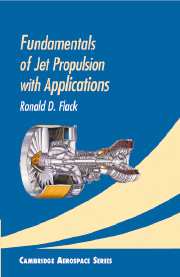Book contents
- Frontmatter
- Contents
- Preface
- Foreword
- Part I Cycle Analysis
- Part II Component Analysis
- 4 Diffusers
- 5 Nozzles
- 6 Axial Flow Compressors and Fans
- 7 Centrifugal Compressors
- 8 Axial Flow Turbines
- 9 Combustors and Afterburners
- 10 Ducts and Mixers
- Part III System Matching and Analysis
- Part IV Appendixes
- References
- Answers to Selected Problems
- Index
8 - Axial Flow Turbines
Published online by Cambridge University Press: 05 June 2012
- Frontmatter
- Contents
- Preface
- Foreword
- Part I Cycle Analysis
- Part II Component Analysis
- 4 Diffusers
- 5 Nozzles
- 6 Axial Flow Compressors and Fans
- 7 Centrifugal Compressors
- 8 Axial Flow Turbines
- 9 Combustors and Afterburners
- 10 Ducts and Mixers
- Part III System Matching and Analysis
- Part IV Appendixes
- References
- Answers to Selected Problems
- Index
Summary
Introduction
As discussed in Chapters 1 to 3, the purpose of the turbine is to extract energy from the fluid to drive the compressive devices. The actual operation of the turbine is in some respects similar to, but opposite that, of the compressor. That is, energy is extracted from the fluid and the pressure and temperature drop through the turbine. Typically, 70 to 80 percent of the enthalpy increase from the burner is used by the turbine to drive the compressor. The remainder is used to generate thrust in the nozzle.
Two major differences are apparent between compressors and turbines, however. First, the pressure decreases through a turbine. In compressors, an adverse pressure gradient is present, which has the potential to cause blade stall. Such problems do not occur in a turbine, and turbine efficiency is typically higher than compressor efficiency. Also, because of this favorable pressure gradient, fewer stages are required for a turbine than for a compressor. As a result, the aerodynamic loading per stage is higher for a turbine than for a compressor. However, the inlet temperature is very high and limits the operation of the turbine. Thus, aerodynamically, the turbine is somewhat easier to design but is structurally more difficult.
- Type
- Chapter
- Information
- Fundamentals of Jet Propulsion with Applications , pp. 406 - 439Publisher: Cambridge University PressPrint publication year: 2005
- 1
- Cited by



